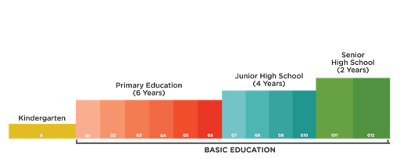K to 12 GABAY PANGKURIKULUM
K TO 12 GABAY PANGKURIKULUM
Baitang 1 to 10
ARALING PANLIPUNAN
4 4 4 4
BALANGKAS NG ARALING PANLIPUNAN
Deskripsyon
Naging batayan ng K-12 Araling Panlipunan Kurikulum ang mithiin ng “Edukasyon para sa Lahat 2015” (Education for All 2015) at ang K-12 Philippine Basic Education Curriculum Framework. Layon ng mga ito na magkaroon ng mga kakayahang kinakailangang sa siglo 21 upang makalinang ng “functionally literate and developed Filipino.” Kaya naman, tiniyak na ang mga binuong nilalaman, pamantayang pangnilalalaman at pamantayan sa pagganap sa bawat baitang ay makapag-aambag sa pagtatamo ng nasabing mithiin. Sa pag-abot ng nasabing mithiin, tunguhin (goal) ng K-12 Kurikulum ng Araling Panlipunan ang makahubog ng mamamayang mapanuri, mapagmuni, mapanagutan, produktibo, makakalikasan, makabansa at makatao na may pambansa at pandaigdigang pananaw at pagpapahalaga sa mga usaping pangkasaysayan at panlipunan.
Katuwang sa pagkamit ng layuning ito ay ang pagsunod sa teorya sa pagkatuto na kontruktibismo, magkatuwang na pagkatuto (collaborative learning), at pagkatutong pangkaranasan at pangkonteksto at ang paggamit ng mga pamaraang tematiko-kronolohikal at paksain/ konseptuwal, pagsisiyat, intregratibo, interdesiplinaryo at multisiplinaryo. Sa pagkamit ng nasabing adhikain, mithi ng kurikulum na mahubog ang pag-iisip (thinking), perpekstibo at pagpapahalagang pangkasaysayan at sa iba pang disiplina ng araling panlipunan ng mag-aaral sa pamamagitan ng magkasabay na paglinang sa kanilang kaalaman at kasanayang pang-disiplina.
Mula sa unang baitang hanggang ika-labindalawang baitang, naka-angkla (anchor) ang mga paksain at pamantayang pang-nilalaman at pamantayan sa pagganap ng bawat yunit sa pitong tema: I) tao, kapaligiran at lipunan 2)panahon, pagpapatuloy at pagbabago, 3) kutlura, pananagutan at pagkabansa, 4) karapatan, pananagutan at pagkamamamayan 5) kapangyarihan, awtoridad at pamamahala, 6)produksyon, distibusyon at pagkonsumo 7) at ungnayang pangrehiyon at pangmundo Samantala, ang kasanayan sa iba’t-ibang disiplina ng araling panlipunan tulad pagkamalikhain, mapanuring pag-iisip at matalinong pagpapasya , pagsasaliksik/ pagsisiyasat, kasanayang pangkasaysayan at Araling Panlipunan, at pakikipagtalastasan at pagpapalawak ng pandaigdigan pananaw, ay kasabay na nalilinang ayon sa kinakailangang pag-unawa at pagkatuto ng mag-aaral sa paraang expanding.
Sa ibang salita, layunin ng pagtuturo ng K-12 Araling Panlipunan na malinang sa mag-aaral ang pag-unawa sa mga pangunahing kaisipan at isyung pangkasaysayan, pangheograpiya, pampulitika, ekonomiks at kaugnay na disiplinang panlipunan upang siya ay makaalam, makagawa, maging ganap at makipamuhay ( Pillars of Learning ). Binibigyang diin sa kurikulum ang pag-unawa at hindi pagsasaulo ng mga konsepto at terminolohiya. Bilang pagpapatunay ng malalim na pag-unawa, ang mag-aaral ay kinakailangang makabuo ng sariling kahulugan at pagpapakahulugan sa bawat paksang pinag-aaralan at ang pagsasalin nito sa ibang konteksto lalo na ang aplikasyon nito sa tunay na buhay na may kabuluhan mismo sa kanya at sa lipunang kanyang ginagalawan.
4 4 4 4
Batayan ng K to 12 Araling Panlipunan Kurikulum
Naging batayan ng K-12 Araling Panlipunan Kurikulum ang mithiin ng “Edukasyon para sa Lahat 2015” (Education for All 2015) at ang K-12 Philippine Basic Education Curriculum Framework. Layon ng mga ito na magkaroon ng mga kakayahang kinakailangang sa siglo 21 upang makalinang ng “functionally literate and developed Filipino.” Nilalayon din ng batayang edukasyon ang pangmatagalang pagkatuto pagkatapos ng pormal na pag-aaral (lifelong learning). Ang istratehiya sa pagkamit ng mga pangkalahatang layuning ito ay alinsunod sa ilang teorya sa pagkatuto na konstruktibismo, magkatuwang na pagkatuto (collaborative learning), at pagkatutong pangkaranasan at pangkonteksto.
4 4 4 4
Ang sakop at daloy ng AP kurikulum ay nakabatay sa kahulugan nito:
Ang Araling Panlipunan ay pag-aaral ng mga tao at grupo, komunidad at lipunan, kung paano sila namuhay at namumuhay, ang kanilang ugnayan at interaksyon sa kapaligiran at sa isa’t isa, ang kanilang mga paniniwala at kultura, upang makabuo ng pagkakakilanlan bilang Pilipino, tao at miyembro ng lipunan at mundo at maunawaan ang sariling lipunan at ang daigidig, gamit ang mga kasanayan sa pagsasaliksik, pagsisiyasat, mapanuri at malikhaing pag-iisip, matalinong pagpapasya, likaskayang paggamit ng pinagkukunang-yaman, at mabisang komunikasyon. Layunin ng Araling Panlipunan ang paghubog ng mamamayang mapanuri, mapagmuni, responsable, produktibo, makakalikasan, makabansa, at makatao, na may pambansa at pandaigdigang pananaw at pagpapahalaga sa mga usapin sa lipunan sa nakaraan at kasalukuyan, tungo sa pagpanday ng kinabukasan.
4 4 4 4
Layunin ng AP Kurikulum
Nilalayon ng AP kurikulum na makalinang ng kabataan na may tiyak na pagkakakilanlan at papel bilang Pilipinong lumalahok sa buhay ng lipunan, bansa at daigdig. Kasabay sa paglinang ng identidad at kakayanang pansibiko ay ang pag-unawa sa nakaraan at kasalukuyan at sa ugnayan sa loob ng lipunan, sa pagitan ng lipunan at kalikasan, at sa mundo, kung paano nagbago at nagbabago ang mga ito, upang makahubog ng indibiduwal at kolektibong kinabukasan. Upang makamit ang mga layuning ito, mahalagang bigyang diin ang mga magkakaugnay na kakayahan sa Araling Panlipunan: (i) pagsisiyasat; (ii) pagsusuri at interpretasyon ng impormasyon; (iii) pananaliksik; (iv) komunikasyon, lalo na ang pagsulat ng sanaysay; at (v) pagtupad sa mga pamantayang pang-etika.

